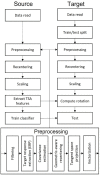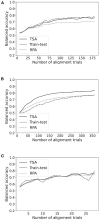Tangent space alignment: Transfer learning for Brain-Computer Interface
- PMID: 36530202
- PMCID: PMC9755175
- DOI: 10.3389/fnhum.2022.1049985
Tangent space alignment: Transfer learning for Brain-Computer Interface
Abstract
Statistical variability of electroencephalography (EEG) between subjects and between sessions is a common problem faced in the field of Brain-Computer Interface (BCI). Such variability prevents the usage of pre-trained machine learning models and requires the use of a calibration for every new session. This paper presents a new transfer learning (TL) method that deals with this variability. This method aims to reduce calibration time and even improve accuracy of BCI systems by aligning EEG data from one subject to the other in the tangent space of the positive definite matrices Riemannian manifold. We tested the method on 18 BCI databases comprising a total of 349 subjects pertaining to three BCI paradigms, namely, event related potentials (ERP), motor imagery (MI), and steady state visually evoked potentials (SSVEP). We employ a support vector classifier for feature classification. The results demonstrate a significant improvement of classification accuracy, as compared to a classical training-test pipeline, in the case of the ERP paradigm, whereas for both the MI and SSVEP paradigm no deterioration of performance is observed. A global 2.7% accuracy improvement is obtained compared to a previously published Riemannian method, Riemannian Procrustes Analysis (RPA). Interestingly, tangent space alignment has an intrinsic ability to deal with transfer learning for sets of data that have different number of channels, naturally applying to inter-dataset transfer learning.
Keywords: Brain-Computer Interface; ERP; Riemannian geometry; SSVEP; domain adaptation; motor imagery; transfer learning.
Copyright © 2022 Bleuzé, Mattout and Congedo.
Conflict of interest statement
The authors declare that the research was conducted in the absence of any commercial or financial relationships that could be construed as a potential conflict of interest.
Figures





References
-
- Barachant A., Bonnet S., Congedo M., Jutten C. (2013). Classification of covariance matrices using a Riemannian-based kernel for BCI applications. Neurocomputing 2013, 172–178. 10.1016/j.neucom.2012.12.039 - DOI
-
- Barachant A., Bonnet S., Congedo M., Jutten C., Riemannian C. J., Bonnet S. (2010). Riemannian geometry applied to BCI classification. Lecture Notes Comput. Sci. 6365, 629–636. 10.1007/978-3-642-15995-4_78 - DOI
-
- Bhatia R. (2009). Positive Definite Matrices. Princeton, NJ: Princeton University Press. 10.1515/9781400827787 - DOI
-
- Bhatia R., Jain T., Lim Y. (2019). On the Bures-Wasserstein distance between positive definite matrices. Exposit. Math. 37, 165–191. 10.1016/j.exmath.2018.01.002 - DOI
LinkOut - more resources
Full Text Sources

